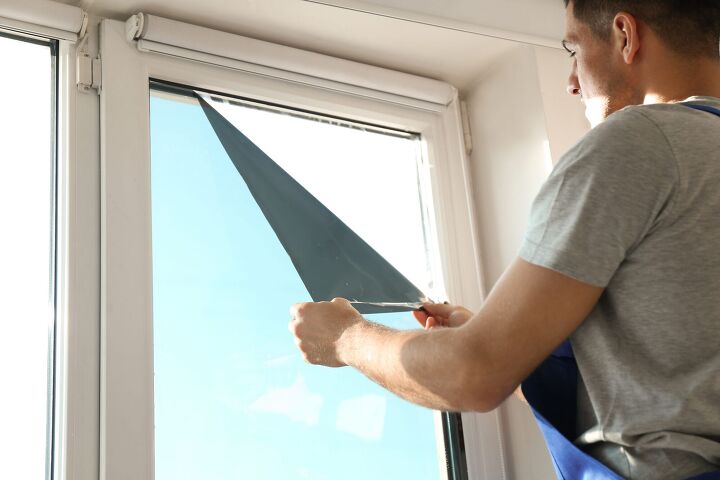How To Block Light From Windows Without Curtains

A room full of natural light is often a big draw for many people. It creates an inviting, bright, and warm atmosphere that appeals to a variety of tastes.
But sometimes there can be too much light, which is why a lot of people have curtains on their windows. But how do you block light without curtains?
You can use window film to dim light from windows without curtains. The film helps reduce the light coming in without blocking the view.
You can also use a folding screen positioned in front of the window as a temporary fix. If the window sill is deep enough, place plants or other items on it to help block the light.
You have several options if you need to darken a room, whether temporarily or for a longer duration. You don’t need to pick out curtains.
Instead, you can pick one of the following methods for blocking the light from windows.
What Can I Use To Block The Sun From My Window?
The most popular ways to block the sun coming in from windows are curtains or something similar, like blinds or shades. However, you might prefer to enjoy an unobstructed view of the outside while keeping the glare and light at bay.
In other cases, you might like a cleaner, more minimalist design scheme and prefer bare windows. No matter what the reason, how do you block light from windows without curtains or blinds?
How Do You Shade A Window Without Curtains?
One of the most convenient ways to reduce the light coming in from your windows is window film. Window film comes in various styles and types.
Some block light and offer privacy, while others reduce glare and let you enjoy the view.
When you apply window film, you can get protection from harmful UV rays. And you can choose how little or how much light you want in the room.
You would select a specific type of film depending on the amount of light you prefer.
Some window films offer additional benefits, like reducing energy bills by absorbing or reflecting heat. Plus, since you don’t need to worry about hanging curtains to block the light, it’s an easy design choice.
If you’re the type who loves to change up your home decor every so often, using window film is a bonus.
You don’t have to worry about swapping out drapery or blinds whenever you change the colors or style in your space. But what type of window tinting is best for you?
1. Black-Out Film
Many black-out window films will block up to 99% of the light and UV rays coming from the window. It will also block most of the view, increasing your overall privacy.
This quality makes this type of film an excellent choice for rooms you want really dark and private. Therefore, you might choose it for a home theatre, bathroom, or bedroom.
2. Whiteout Window Tint
If you want a little bit of light but still prefer privacy, go for whiteout film. It filters the light that comes through, only letting in about 10% of the light, keeping it soft and dim.
However, it still offers a reasonable degree of privacy. It would be an optimal choice for a bathroom, entry doors, sidelights, and room dividers.
3. Solar Control Window Film
Look into solar control film if you want to block the glare and reduce your energy bills. Depending on where you get it, it can reduce up to 91% of the glare, 99% of UV rays, and almost 80% of the sun’s heat.
You could potentially save up to 50% on energy costs.
4. Reflective Window Film
The exterior side of this window film is highly reflective, blocking light coming through the windows and reducing heat. It also decreases the interior reflectivity, making it easier to see out the window at night.
5. Decorative Window Films
You can also find window films that are more decorative in nature. These films will be more affordable. However, they don’t typically block a lot of heat or UV rays.
They are more for decor and privacy purposes, but they will help reduce glare and light somewhat. It could be a good option if you simply want to minimize the amount of light coming through the windows.
If you decide to use window film, do your research. Window films should be rated by the National Fenestration Rating Council (NFRC).
These ratings display how well the particular tint is at blocking light, heat, and other factors.
Depending on your budget, window film may or may not be an option for you. Most window film costs between $2 and $14 per square foot, depending on the type and quality.
In addition, you can expect to pay another $5 to $10 per square foot for installation.
How Can I Cover My Windows Cheaply?
If window tint isn’t in the cards in the near future, thanks to your budget, you have some other options.
1. Use The Window Sills
If the window sills are deep enough, you can set some tall plants on them to help filter light. Using the window sills as display shelves won’t necessarily block all the light or UV rays, but it will help reduce the amount of light coming from the windows and provide some privacy.
2. Install Glass Window Shelves
If you don’t have a window sill or it’s too shallow, consider glass shelving. Hang a couple of glass shelves across the window. Use them to display plants and other items to help provide some privacy and block some of the light.
3. Use Hanging Plants
You can also install a curtain rod or dowels across the window and hang plants to block the light. Or, suspend the plants from the ceiling in hanging baskets.
Other options for displaying items are vases, statues, and various decorative elements.
4. Make a DIY Window Covering
If you don’t mind having a window covering, make an easy DIY roller shade. You can pull it down when you need to block the light. But you won’t have to stretch your wallet on expensive window treatments.
Another option is to hang wood slats from a rod for a more rustic, vertical window dressing. You can also tie strands of ribbon to a dowel or rope that runs across the top of the window.
How To Blackout Windows Temporarily
If you just need to block light from windows temporarily, you can use a room divider or folding screen. Position it in front of the window when you need to block the light, then move it when you don’t.
You can also hang a blanket or sheet, but be forewarned, your room will look like a freshmen dorm room for the moment. You can also move a tall bookshelf or another piece of furniture in front of the window.
Once you don’t need to block the light anymore, you can simply move it out of the way.
Extra Tips For Darkening Your Room Without Curtains
If you need to darken your room a bit and don’t have a way to block more light from the window, look elsewhere.
- Install draft stoppers on doors to block light coming from underneath.
- Avoid using mirrors in the space, as they reflect light around the room.
- Choose non-reflective paint colors for your design scheme, like charcoal gray or other light-absorbing, darker tones.
- Install dimmer switches on your lights.
- Choose low-wattage bulbs for some fixtures and only use those when you want a little light.
Keep Away From The Light
Natural light is great, but sometimes, you don’t want it coming into your space. If curtains aren’t your jam, no problem. You can block the light using different types of window film.
Some films even help reduce your energy costs by blocking heat or reflecting heat into the room during the winter. But if window film isn’t in your budget, you can position tall plants on the window sill to help filter light.
Another option is to hang glass shelves or suspend plants from the ceiling or a rod.
If you only need a temporary way to block light coming through the window without curtains, use a folding screen. Move it or a tall piece of furniture in front of the window.
You could also hang a blanket or a sheet in a pinch.
No matter which way you decide to block the light, make sure you consider your other needs. Do you also want privacy or still want to enjoy the view? Do you need total darkness, or do you prefer soft light?
Answering these questions will help you choose the best light-blocking method for you.
Related Guides:

Stacy Randall is a wife, mother, and freelance writer from NOLA that has always had a love for DIY projects, home organization, and making spaces beautiful. Together with her husband, she has been spending the last several years lovingly renovating her grandparent's former home, making it their own and learning a lot about life along the way.
More by Stacy Randall



























